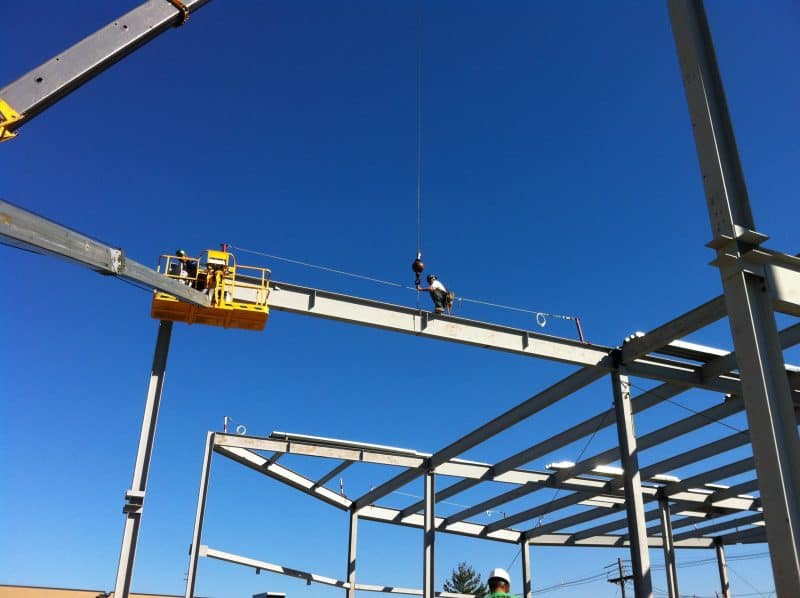Steel Erection Best Practices Regarding Safety
- Create a culture in company that buys into safety from top to bottom.
- Have a Written Safety Program and Accident Prevention Guidelines for Field Construction. That is signed and followed by management and all employees.
- Require 100% Fall Protection over 6′
- Know OSHA Subpart R
- Make it mandatory to keep a clean well-organized site an keep all tools and equipment in top shape.
- Highly qualified and trained workforce of Ironworkers
Safety is first and foremost on every project. Most importantly safety allows each and every-worker to go home to their family after each shift, it is also important to note that financially, safety is very important to a Steel Erection company. It can literally put a company out of business due to the high cost of work-man’s comp insurance.
If a Steel Erector has many accidents his WC rate will go up, which will make it tough to compete in the market place. A high experience modifier can also disqualify an Erector from submitting a price on some projects where owners require a 1.0 or lower mod rate.
Written Safety Program and Accident Prevention Guidelines
Safety within a company is a culture that must be created and must have buy in from top to bottom. A company safety policy must be created and followed throughout the company with documentation of each employee reviewing and signing to show their commitment to follow the company’s safety policies.
Here is a link to one of our old safety plans that may offer some ideas on structure and content.
http://steelestimatingsolutions.com/wp-content/uploads/2018/02/Safety_Plan.pdf
100% Fall Protection Over 6′
Fall Protection is at the top of the list. OSHA Subpart R now defines fall protection limits at 15′ and up to 30′ for connectors. In today’s environment and with many General Contractors having a 6′ fall protection rule in place for projects, it is my opinion best to get set up with 100% fall protection over 6′ no matter the activity the ironworker is engaging in, this way it takes all guess work out of it and not depending on which project they are on, it is always across the board 100% fall protection over 6’
There are many ways to make 100% fall protection happen.
- Stanchion Post System designed by an Erector that is engineered and stamped to take the required forces (ones on market are expensive but is an option)
- Beamers & Tie-off Chokers
- Using boomlifts and sissorlifts
- Fall Restraint Systems
- Working with fabricator to design the Fall Arrest System into project
- Retractable reels
Know OSHA Subpart R
The Occupational Safety and Health Administration (OSHA) revised the steel erection standard (29 CFR 1926 Subpart R). The revised standard is the result of years of joint efforts between the steel erection industry, industry experts and OSHA. This negotiated rule establishes new performance criteria not just for the physical steel erection, but also for fall protection, employee safety training, rigging practices and crane safety. The rule became effective on Jan. 18, 2002.
The new rule outlines procedures for several practices that were not addressed in the previous standard. It establishes procedures for multiple rigged lifts, detailed requirements for daily crane inspections, rigging inspections, rigger qualifications and connecting methods. The most notable change is that it establishes a height of 15 feet as the new action level for fall protection.
Here is a link to a good slide show on Subpart R
http://www.slideshare.net/FFSafety/subpart-r-steel-erection
The standard is divided into several sections:
• Scope of coverage.
• Definitions.
• Site layout, site-specific erection plan and construction sequence.
• Hoisting and rigging.
• Methodology.
• Fall protection.
• Training requirements.
Scope of Coverage
Most people would initially expect that this standard only covers ironworkers. This is not the case. Beyond what most would consider steel erection, activities covered under this standard also include erecting ornamental iron, window walls, stone and other siding systems, etc. All contractors should review this section of the standard to see if any of their work may be regulated here.
Definitions
This section lists definitions for the numerous terms discussed in the standard. Terms that necessitate close scrutiny include connector, competent person, qualified person, controlled decking zone, fall restraint system, multiple lift rigging and controlled load lowering.
Site Layout, Site-Specific Erection Plan and Construction Sequence
This section is one of the more significant additions to the new rule. It requires that the controlling contractor provide “adequate access roads into and through the site for the safe delivery and movement of…” cranes, derricks, materials, etc. The controlling contractor is also responsible for providing “a firm, properly graded, drained area, readily accessible to the work with adequate space for the safe storage of materials and the safe operation of the erector’s equipment.” This section also stipulates certain written notifications regarding the concrete in the footings, and anchor bolt modifications.
Hoisting and Rigging
This section establishes inspection requirements for cranes, operator responsibilities and multiple lift rigging procedures. It also discusses those times when it is permitted to work under a suspended load, and how to pre-plan the routes for suspended loads. A very important addition here states that “a qualified rigger (a rigger who is also a qualified person) shall inspect the rigging prior to each shift in accordance with 1926.251.” Clearly, the intent is to require that the rigger be an individual with a high degree of expertise, as found in the definition of a qualified person in section 1926.751.
Methodology
These sections deal with the actual methodology of erecting beams, columns, joists, decking and systems- engineered buildings. Pay attention to the requirements for roof and deck openings discussed under 1926.754 (e)(2), particularly paragraph (iii) which states that “metal decking holes and openings shall not be cut until immediately prior to being permanently filled with the equipment.…” The other option is that they be immediately covered. The requirements for covers are listed here and are identical to those found in the fall protection standard (Subpart M).
Fall Protection
This is the most important section of the standard because it deals with controlling the greatest hazard faced by employees during steel erection. This section should be reviewed in detail. Briefly, here are the basic requirements:
1. Fall protection action level of 15 feet for all work except connecting and working within a controlled decking zone (CDZ).
2. Acceptable protection includes safety net systems, guardrail systems, personal fall arrest systems, positioning device systems or fall restraint systems.
3. The criteria for fall protection equipment is identical to 1926.502, the fall protection standard, which is incorporated by reference therein.
4. Perimeter safety cables on multi-story buildings must be installed on the final perimeter as soon as the decking has been installed.
5. Connectors and employees working in CDZs have different fall protection requirements. A CDZ consists of an area not more than 90 feet wide and 90 feet deep from any leading edge and is marked by the use of control lines or equivalent. Access to a CDZ is limited only to those employees engaged in leading edge work. There are specific training requirements for employees working in a CDZ.
6. The “Custody of Fall Protection” paragraph states that the fall protection installed by the steel erector can only be left on the building if the controlling contractor has inspected, and accepted control and responsibility for that fall protection system.
Training Requirements
This section outlines the specific training that must be given to employees who are exposed to falls, as well as special training programs for multiple rigged lifts, connectors and employees who work in controlled decking zones. A qualified person, as defined in section 1926.751, must provide this training.
Link to Subpart R
https://www.law.cornell.edu/cfr/text/29/part-1926/subpart-R
Clean an Well-Organized Site an Maintained Tools and Equipment
A clean a well-organized site and well-maintained tools an equipment makes for a safe site. This goes hand in hand with the culture of the company. People often do not recognize housekeeping as a safety issue until after an incident has occurred. That is when bad housekeeping is revealed.
Day-to-day housekeeping and cleanliness should not be left for employees to do during the last few minutes of the workday. Housekeeping should be an ongoing effort.
Steel Erectors relies on heavy equipment, power tools, forklifts, cranes and other pieces of machinery to enable maximum productivity – but the very power that makes this equipment so effective also makes it dangerous.
If not responsibly operated and maintained, the tools of the construction trade can cause serious workplace injuries.
Highly Trained Workforce of Ironworkers
A highly train workforce of Ironworkers is imperative to safety. One of the benefits of using Union Ironworkers is the union supplies trained Ironworkers that carry cards as proof of all the training’s required IE… Fall Protection training, Forklift training, Boomlift training, Sissorlift training, Confined Space training, OSHA 10 and 220-hour training, Welding Certifications, Foremen training and a Drug testing program that has teeth.
Of course, a Steel Erector can pay to have all his Ironworkers to have these trainings on their own, create a data base so that they can ensure all trainings are current and not expired.
In my opinion getting well qualified and trained Ironworkers is KEY to safety, when it comes to Best Steel Erection Practices.
Next section is Plans
Vince Hughes
Steel Estimating Solutions
505-249-2390
PS… If you are looking to take your estimating process into the 21st century, Steel Estimating Solutions can be a great resource to help you make that happen. I have been doing digital takeoffs since 2001 and have developed a pricing tool (actually much more than that) called the Steel Erection Bid Wizard. I have helped over 260 Steel Erectors to make the transition and would love to help you as well. Give me a call anytime.
Steel Erection Bid Wizard
Join dozens of your peers that have revolutionized the way they estimate. Take your estimating department digital with Steel Erection Bid Wizard. Only software on the market made for Erectors by an Erector.
Steel Erection Bid Wizard is a fully functional Windows – based software package. Estimate your bids more quickly and easier than ever before.
Benefits of The Steel Erection Bid Wizard
- Reduce the time it takes to estimate by 50% or more
- Tried & true production rates for labor, crane & weld time
- You can easily adjust production rates to fit your company
- More than 300 built-in tasks
- Ability to create your own tasks and add new categories
- Generate one-touch proposals
- Integrate with multiple takeoff software’s
- Peace of mind


